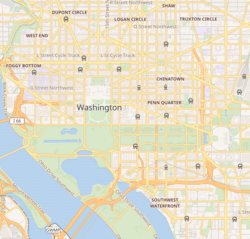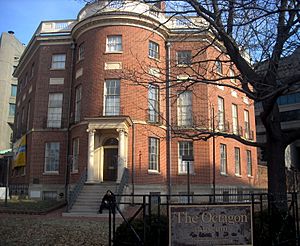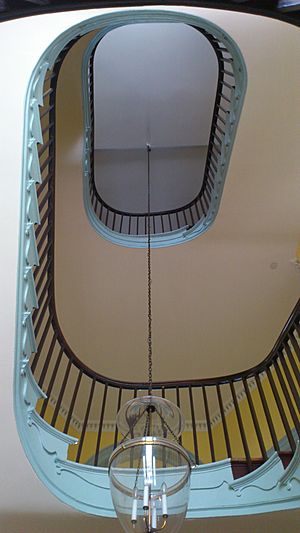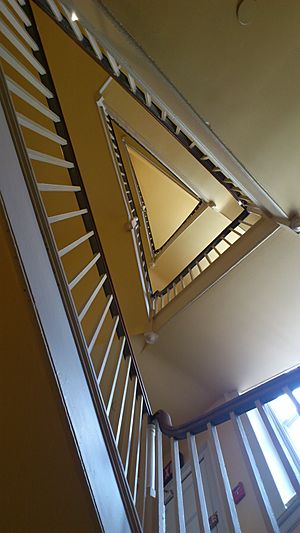The Octagon House facts for kids
|
The Octagon House
|
|
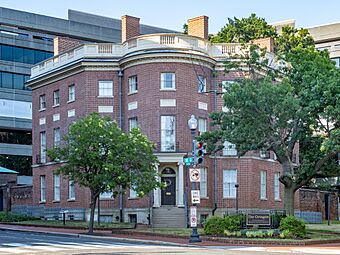
The Octagon House in 2024
|
|
| Location | 1799 New York Avenue, Northwest, Washington, D.C., U.S. |
|---|---|
| Built | 1799 |
| Architect | William Thornton |
| Architectural style | Federal |
| NRHP reference No. | 66000863 |
Quick facts for kids Significant dates |
|
| Added to NRHP | October 15, 1966 |
| Designated NHL | December 19, 1960 |
The Octagon House, also known as the Colonel John Tayloe III House, is a historic building in Washington, D.C.. It is located at 1799 New York Avenue in the Foggy Bottom area. Built in 1799, it was designed by William Thornton, who also designed the United States Capitol.
The house was built for John Tayloe III, a very wealthy landowner. He was encouraged by George Washington to build his home in the new capital city. The Octagon House became famous during the War of 1812. In September 1814, after British forces burned the White House, President James Madison and First Lady Dolley Madison lived here for six months. It is one of only five houses in U.S. history to serve as a presidential residence. Today, it is one of only three such houses that still stand.
John Tayloe III was born at Mount Airy, a large family estate in Virginia. He studied in England at Eton College and Cambridge University. He was known as one of the richest landowners of his time. The Octagon House was first meant to be a winter home for the Tayloe family. However, they lived there year-round from 1818 to 1855. The property once had many smaller buildings, like stables and a smokehouse. The Tayloes had many workers, including 12 to 18 who worked at the Octagon House.
Contents
History of the Octagon House
Building the House
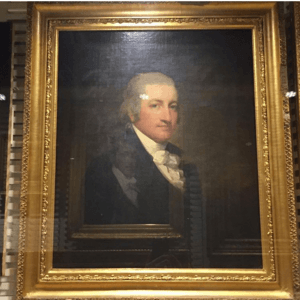
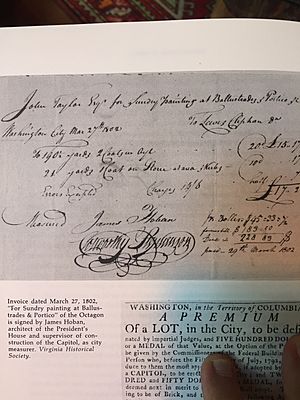
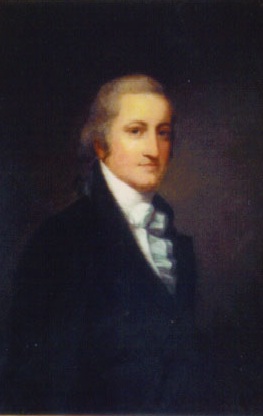
John Tayloe III and his wife, Ann Ogle, first thought about building a home in Philadelphia. But George Washington convinced them to build in the new capital city, Washington, D.C. Washington wanted to help the new city grow. Tayloe chose William Thornton as his architect. Thornton had also designed the United States Capitol.
On April 19, 1797, Tayloe bought the land for $1,000. This land was in a quiet area, west of the partly built President's House. The lot was an unusual triangle shape. Thornton had to design a house that would fit this unique lot. He made the house relate to both streets, creating two walls at a 70-degree angle. The house actually has six sides, but the Tayloes called it "The Octagon."
The house was built with strong brick and trimmed with Aquia Creek sandstone. The inside was very fancy. The doors on the first floor were made of mahogany. The circular entrance hall had curved doors and windows. There were even secret doors in the back hall and dining room. These doors were hidden so well that you couldn't see hinges or keyholes.
The Tayloes had 15 children, and 13 of them lived to be adults. Their children were born between 1793 and 1815. Their oldest son, John Tayloe IV, served in the U.S. Navy during the War of 1812.
The War of 1812 and Presidential Stay
John Tayloe III was not a big supporter of President James Madison or the War of 1812 with England. However, he was active in the local militia. When British forces marched into Washington in August 1814, a French flag was flying outside the Octagon. Ann Ogle Tayloe had offered the house to the French consul. This helped protect the house from being burned by the British. The British had orders not to damage private homes.
After the White House was burned, President James Madison and his wife, Dolley Madison, moved into the Octagon. They lived there from September 8, 1814, until March 1815. President Madison signed the Treaty of Ghent in an upstairs study at the Octagon on February 17, 1815. This treaty officially ended the War of 1812. Dolley Madison was also known for hosting parties, called "squeezes," at the Octagon. The Tayloes received $500 for the Madisons' six-month stay.
Later Years of the House
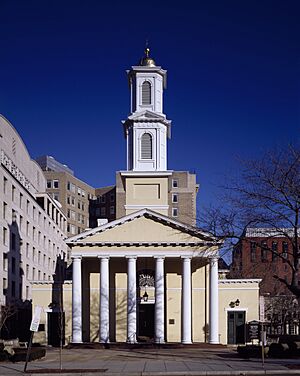
John Tayloe III died in 1828 while at the Octagon. Ann Ogle Tayloe lived in the house until she passed away in 1855. After her death, the Tayloe children rented out the house. It was used as a girls' school in the 1860s. In the 1870s, the U.S. Navy used it for offices. By the 1880s, many families lived in the house, perhaps one in each room.
In 1898, the American Institute of Architects (AIA) chose the Octagon as their new national headquarters. They rented it for four years, then bought it in 1902. The Octagon served as the AIA's main office until the 1960s.
The Octagon Museum
The Octagon House opened as a museum in 1970. In the early 1990s, the museum was restored to look like it did around 1817–1818. The colors of the walls and the way the rooms are set up today show how it looked back then.
The museum was managed by the American Architectural Foundation for many years. It was closed from 2007 to 2013 for renovations. Today, the American Institute of Architects Foundation runs the museum. It offers self-guided tours, special exhibits, and public programs. The Octagon House was named a National Historic Landmark in 1960.
The museum is open to the public on Fridays and on the first and third Saturdays of each month. It hosts various events, educational tours, and changing exhibits.
Architectural Design
The Octagon House is a three-story brick building. Its unique shape was designed to fit an unusual triangular lot. It was a new style for its time, different from older Georgian and Federal homes. The Octagon is considered a top example of Federal architecture in the United States. It combines a circle, two rectangles, and a triangle in its design. The inside and outside decorations are very elegant.
Some decorative items and furniture were brought from England. However, most building materials, like bricks, wood, iron, and Aquia Creek sandstone, were made locally.
It's not fully known why the six-sided building was called "The Octagon." One idea is that it looked like octagonal rooms common in England, which were often circular but built with eight walls. Another idea is that the eight angles formed by the house's unusual shape fit an old definition of an octagon.
Alleged Hauntings
The Octagon House is said to be one of the most haunted homes in Washington, D.C. People have reported seeing and feeling strange things in many parts of the house. These include the spiral staircase, the second and third floor landings, a third-floor bedroom, and the garden. Visitors, museum staff, and curators have all reported these experiences.
There are many ghost stories about the Octagon House. Since it is one of the oldest buildings in the city, it is a popular setting for spooky tales. The stories shared here are just some of the legends that have grown over the past 200 years. They are not historical facts.
Ringing Bells
One of the oldest ghost stories is about the mysterious ringing of the house's call bells. These bells were used to summon workers. The legend says that the spirits of former workers would ring these bells loudly. This ghostly ringing is believed to have started in the mid-1800s.
Virginia Tayloe Lewis, a granddaughter of John Tayloe III, wrote about this family memory. She said, "The bells rang for a long time after my Grandfather Tayloe's death, and every one said that the house was haunted; the wires were cut and still they rang…" Even when the wires were cut, the bells supposedly kept ringing.
By 1874, the bell legend was well known. Mary Clemmer Ames wrote that every night at the same hour, all the bells would ring at once. She mentioned a story where a man tried to stop the ringing by grabbing the wires. But he was lifted off the floor, and the bells kept ringing. Some people believed rats caused the ringing, while others said the cause was never found. The family eventually took the bells down to find peace.
The original call bells are no longer in the house. There are no reports of them ringing today.
Dolley Madison's Ghost
Many ghost stories at the Octagon involve its early history as a place for important people. Dolley Madison is a key figure in these legends. She was famous for hosting parties in the early 1800s. She is a popular ghost in Washington, D.C., and is said to haunt several buildings. Dolley and James Madison lived in the Octagon House after the White House was burned.
According to the legends, Dolley Madison still hosts ghostly parties at the Octagon. She is supposedly seen most often in the front hall and drawing room. People say they can smell lilacs when her ghost is present.
Colonel Tayloe's Daughters
The most detailed and popular legends about the Octagon involve the deaths of the Tayloe daughters. These stories are so well known that visitors often believe they are true. However, there is no historical proof to support any of them.
These legends first appeared in a 1908 newspaper article. They often follow a similar storyline: Two of Colonel Tayloe's daughters are said to haunt the Octagon. One supposedly died before the War of 1812. The story says Colonel Tayloe and his daughter argued on the second-floor landing. She then fell down the stairs (or over the railing) and died. Her ghost is reportedly seen at the bottom of the stairs or near the second-floor landing. Sometimes, her ghost appears as a candle light moving up the staircase.
Another story claims a second daughter died in 1817. This daughter supposedly ran away with a young man, making her father angry. When she returned home to make up with him, they argued on the third-floor landing. This daughter also fell to her death down the stairs (or over the railing). Her ghost is said to haunt the third-floor landing and the stairs between the second and third floors.
There is no historical evidence for these stories. None of the Tayloes' daughters died in the Octagon House. Of their seven daughters, only three died before age 30. One died as a baby in 1800 and never lived in the Octagon. Rebecca Plater Tayloe died in 1815 at age 18, but the family was staying at their Mount Airy Plantation at the time. Elizabeth Mary Tayloe died in 1832 at age 26 in Washington, D.C., but not at the Octagon House.
Other Ghostly Reports
By 1888, the Octagon was well known as a haunted house. It is reported that twelve men decided to spend a night there to prove the legends wrong. A first-hand account was printed in a local newspaper. It described screams, the clanking of swords, and the sound of footsteps.
Museum superintendent Alric H. Clay claimed that in the 1960s, spirits would often turn on the lights and open the Octagon's doors late at night.
In the late 1940s, a doctor visiting the house had a strange experience on the stairway. He asked the caretaker if there was a costume party because he had seen a man in an early 1800s military uniform on the stairs. The caretaker said there was no party.
A gambler who was reportedly shot to death in the house's third-floor bedroom in the late 1800s has been seen in that room. A 1912 newspaper article told of a man who stayed in a room at the Octagon. He claimed the spirit of a man killed over a card game visited him nightly.
Many other strange things have been reported at the Octagon. People say they hear the sound of rustling silk on the main staircase. The hanging lamp in the main hallway supposedly swings by itself. Some people feel forced to avoid a spot at the foot of the main staircase. One curator reportedly found "tiptoeing tracks of human feet in the undisturbed dust of the top floor landing."
See also
 In Spanish: The Octagon House para niños
In Spanish: The Octagon House para niños
- Benjamin Ogle Tayloe House
- List of National Historic Landmarks in the District of Columbia
- List of octagon houses
- List of octagonal buildings and structures in the United States
- List of the oldest buildings in Washington, D.C.
- Mount Airy, Richmond County, Virginia
- John Tayloe III
- William Thornton
- Architecture of Washington, D.C.


